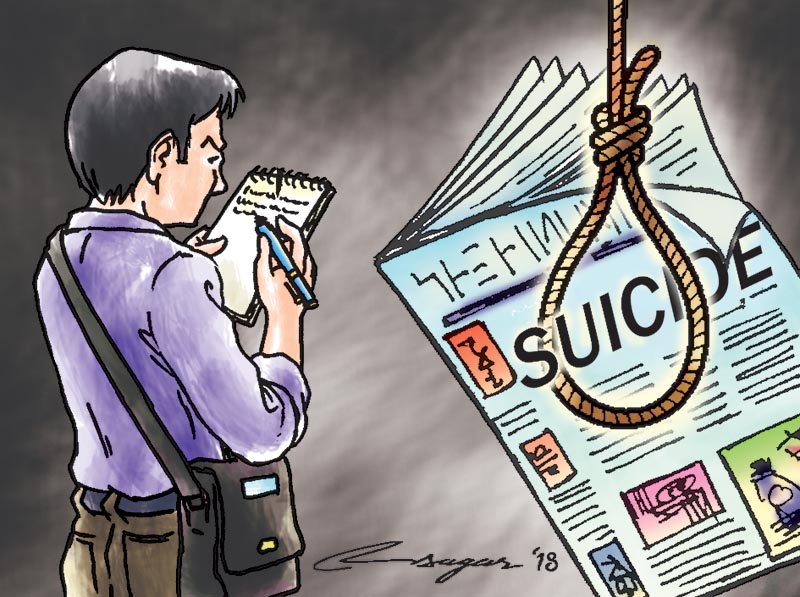Suicide and the media: A degree of caution is required
Talking sensitively about mental health problems and suicide reduces stigma and can save lives. Journalists working in all forms of the media can make a difference to reduce the grim national suicide rate
Suicide is mostly preventable and every citizen has a part to play. The way the media report suicide matters. Yet, concerns have been raised about the “sensational and glorified’ reporting of suicide in the Nepali media – including social media -- that perpetuates myths as well as reinforces stigma. Research shows that this kind of sensational reporting can encourage further suicide. Therefore, to reduce suicide the media has a vital role to play in the way suicide is reported.
In Nepal, suicide is a growing mental health as well as a public health concern. The national official suicide rate is 16.4 per 100,000 (2015-16). These figures are believed to be an underestimation and the World Health Organisation estimates the rate to be 24.9 per 100,000. This puts Nepal into having the seventh highest suicide rate in the world. Responsive to the need to prevent suicide, the Ministry of Health has set a target to reduce suicide to 14.2 per 100,000 by 2020. More is known in Nepal about female suicide in comparison to male suicide. Research highlights that young people in Nepal are particularly vulnerable to suicide and suicidal behaviour. Global evidence indicates that young people at risk of suicide are put at even greater risk as a result of insensitive media reporting. Nepal has no comprehensive reporting of suicide or suicidal behaviour, and the official suicide data relies on police records. It is believed that stigma and perceived negative consequences to the family encourage under-reporting of suicide.
The Muluki Ain, the country’s civil code, does not criminalise suicide. But there is a legal provision to investigate homicide and suspicious suicides. As a result it is commonplace in the media as well as in academic papers to report suicide as a criminal act. This leads to further stigma and under-reporting.
Other agencies collect information related to suicide but this remains fragmented as it is not centrally collated. There is an urgent need for work to reduce stigma of suicide and improved official reporting and documentation of suicide. In the absence of more accurate information, the professionals working on suicide face an obstacle when it comes to addressing suicide prevention. Amongst this professional group there is consensus for better inter-agency and cross-sector collaboration to respond to the growing suicide crisis and for a national suicide prevention strategy. This coordination remains to be implemented.
It is important to remember suicide and suicidal behaviour concern people of all ages from all walks of life. With every suicide there is a human tragedy. When people consider suicide, they find themselves at a very low point, confused and floundering in helplessness. When this point is experienced, it usually lasts for only a short time. This is a crucial time to talk with the person and distract him/ her from the threatened action to prevent a death.
A sensationalised media report with explicit details of a suicide can be enough to trigger a further suicide. Once a suicide is prevented, a life is saved and it’s then possible to follow up with professional support to find out ways to manage a person’s troubled thoughts. Repeated attempts are rare indicating that once a person survives the crisis, s/he rarely goes on to try to take one’s life again. The traditional media – newspapers, radio, TV – and social media have an important role to play to prevent suicide.
A helpful way to proceed is a more sensitive coverage that discusses the holistic nature of mental health problems to include social, psychological and medical aspects. The media trend to put emphasis on a single factor – economic problems or examination stress – is not so useful.
Talking sensitively about mental health problems and suicide reduces stigma and can save lives. Journalists, working in all forms of the media can make a difference to reduce the grim national suicide rate.
Accurate information must be provided about where to seek help, while the public needs to be educated about the facts of suicide and suicide prevention, without spreading myths. Media should report stories on ways to cope with life stressors or suicidal thoughts, and how to get help. Caution should be exercised while reporting celebrity suicides and interviewing bereaved family or friends. Media professionals must recognise that they themselves might be affected by stories about suicide.
Mediapersons also need to pay due consideration to what they should “not do” while reporting suicide events. They should avoid placing stories about suicide prominently and should unduly repeat such stories. Language which sensationalises or normalises suicide should be avoided, while presentation should focus on a constructive solution to problems. Explicit description of the method of suicide, unnecessary details about the site/ location, sensational headlines and use of photographs, video footage or social media links should be avoided.
Journalists working with mental health and public health professionals, social workers, researchers, civil society organisations working to reduce suicide together with the Government of Nepal will help save lives. Responsible reporting on suicide requires a degree of caution to balance the public’s right to know against the risk of causing harm.
Robertson, PhD, is honorary fellow at University of Edinburgh






